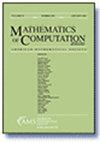求助PDF
{"title":"在Tribonacci数列的𝑝-adic零点上","authors":"Yuri Bilu, Florian Luca, Joris Nieuwveld, Joël Ouaknine, James Worrell","doi":"10.1090/mcom/3893","DOIUrl":null,"url":null,"abstract":"Let <inline-formula content-type=\"math/mathml\"> <mml:math xmlns:mml=\"http://www.w3.org/1998/Math/MathML\" alttext=\"left-parenthesis upper T Subscript n Baseline right-parenthesis Subscript n element-of double-struck upper Z\"> <mml:semantics> <mml:mrow> <mml:mo stretchy=\"false\">(</mml:mo> <mml:msub> <mml:mi>T</mml:mi> <mml:mi>n</mml:mi> </mml:msub> <mml:msub> <mml:mo stretchy=\"false\">)</mml:mo> <mml:mrow class=\"MJX-TeXAtom-ORD\"> <mml:mi>n</mml:mi> <mml:mo>∈<!-- ∈ --></mml:mo> <mml:mrow class=\"MJX-TeXAtom-ORD\"> <mml:mrow class=\"MJX-TeXAtom-ORD\"> <mml:mi mathvariant=\"double-struck\">Z</mml:mi> </mml:mrow> </mml:mrow> </mml:mrow> </mml:msub> </mml:mrow> <mml:annotation encoding=\"application/x-tex\">(T_n)_{n\\in {\\mathbb Z}}</mml:annotation> </mml:semantics> </mml:math> </inline-formula> be the Tribonacci sequence and for a prime <inline-formula content-type=\"math/mathml\"> <mml:math xmlns:mml=\"http://www.w3.org/1998/Math/MathML\" alttext=\"p\"> <mml:semantics> <mml:mi>p</mml:mi> <mml:annotation encoding=\"application/x-tex\">p</mml:annotation> </mml:semantics> </mml:math> </inline-formula> and an integer <inline-formula content-type=\"math/mathml\"> <mml:math xmlns:mml=\"http://www.w3.org/1998/Math/MathML\" alttext=\"m\"> <mml:semantics> <mml:mi>m</mml:mi> <mml:annotation encoding=\"application/x-tex\">m</mml:annotation> </mml:semantics> </mml:math> </inline-formula> let <inline-formula content-type=\"math/mathml\"> <mml:math xmlns:mml=\"http://www.w3.org/1998/Math/MathML\" alttext=\"nu Subscript p Baseline left-parenthesis m right-parenthesis\"> <mml:semantics> <mml:mrow> <mml:msub> <mml:mi>ν<!-- ν --></mml:mi> <mml:mi>p</mml:mi> </mml:msub> <mml:mo stretchy=\"false\">(</mml:mo> <mml:mi>m</mml:mi> <mml:mo stretchy=\"false\">)</mml:mo> </mml:mrow> <mml:annotation encoding=\"application/x-tex\">\\nu _p(m)</mml:annotation> </mml:semantics> </mml:math> </inline-formula> be the exponent of <inline-formula content-type=\"math/mathml\"> <mml:math xmlns:mml=\"http://www.w3.org/1998/Math/MathML\" alttext=\"p\"> <mml:semantics> <mml:mi>p</mml:mi> <mml:annotation encoding=\"application/x-tex\">p</mml:annotation> </mml:semantics> </mml:math> </inline-formula> in the factorization of <inline-formula content-type=\"math/mathml\"> <mml:math xmlns:mml=\"http://www.w3.org/1998/Math/MathML\" alttext=\"m\"> <mml:semantics> <mml:mi>m</mml:mi> <mml:annotation encoding=\"application/x-tex\">m</mml:annotation> </mml:semantics> </mml:math> </inline-formula>. For <inline-formula content-type=\"math/mathml\"> <mml:math xmlns:mml=\"http://www.w3.org/1998/Math/MathML\" alttext=\"p equals 2\"> <mml:semantics> <mml:mrow> <mml:mi>p</mml:mi> <mml:mo>=</mml:mo> <mml:mn>2</mml:mn> </mml:mrow> <mml:annotation encoding=\"application/x-tex\">p=2</mml:annotation> </mml:semantics> </mml:math> </inline-formula> Marques and Lengyel found some formulas relating <inline-formula content-type=\"math/mathml\"> <mml:math xmlns:mml=\"http://www.w3.org/1998/Math/MathML\" alttext=\"nu Subscript p Baseline left-parenthesis upper T Subscript n Baseline right-parenthesis\"> <mml:semantics> <mml:mrow> <mml:msub> <mml:mi>ν<!-- ν --></mml:mi> <mml:mi>p</mml:mi> </mml:msub> <mml:mo stretchy=\"false\">(</mml:mo> <mml:msub> <mml:mi>T</mml:mi> <mml:mi>n</mml:mi> </mml:msub> <mml:mo stretchy=\"false\">)</mml:mo> </mml:mrow> <mml:annotation encoding=\"application/x-tex\">\\nu _p(T_n)</mml:annotation> </mml:semantics> </mml:math> </inline-formula> with <inline-formula content-type=\"math/mathml\"> <mml:math xmlns:mml=\"http://www.w3.org/1998/Math/MathML\" alttext=\"nu Subscript p Baseline left-parenthesis f left-parenthesis n right-parenthesis right-parenthesis\"> <mml:semantics> <mml:mrow> <mml:msub> <mml:mi>ν<!-- ν --></mml:mi> <mml:mi>p</mml:mi> </mml:msub> <mml:mo stretchy=\"false\">(</mml:mo> <mml:mi>f</mml:mi> <mml:mo stretchy=\"false\">(</mml:mo> <mml:mi>n</mml:mi> <mml:mo stretchy=\"false\">)</mml:mo> <mml:mo stretchy=\"false\">)</mml:mo> </mml:mrow> <mml:annotation encoding=\"application/x-tex\">\\nu _p(f(n))</mml:annotation> </mml:semantics> </mml:math> </inline-formula> where <inline-formula content-type=\"math/mathml\"> <mml:math xmlns:mml=\"http://www.w3.org/1998/Math/MathML\" alttext=\"f left-parenthesis n right-parenthesis\"> <mml:semantics> <mml:mrow> <mml:mi>f</mml:mi> <mml:mo stretchy=\"false\">(</mml:mo> <mml:mi>n</mml:mi> <mml:mo stretchy=\"false\">)</mml:mo> </mml:mrow> <mml:annotation encoding=\"application/x-tex\">f(n)</mml:annotation> </mml:semantics> </mml:math> </inline-formula> is some linear function of <inline-formula content-type=\"math/mathml\"> <mml:math xmlns:mml=\"http://www.w3.org/1998/Math/MathML\" alttext=\"n\"> <mml:semantics> <mml:mi>n</mml:mi> <mml:annotation encoding=\"application/x-tex\">n</mml:annotation> </mml:semantics> </mml:math> </inline-formula> (which might be constant) according to the residue class of <inline-formula content-type=\"math/mathml\"> <mml:math xmlns:mml=\"http://www.w3.org/1998/Math/MathML\" alttext=\"n\"> <mml:semantics> <mml:mi>n</mml:mi> <mml:annotation encoding=\"application/x-tex\">n</mml:annotation> </mml:semantics> </mml:math> </inline-formula> modulo <inline-formula content-type=\"math/mathml\"> <mml:math xmlns:mml=\"http://www.w3.org/1998/Math/MathML\" alttext=\"32\"> <mml:semantics> <mml:mn>32</mml:mn> <mml:annotation encoding=\"application/x-tex\">32</mml:annotation> </mml:semantics> </mml:math> </inline-formula> and asked if similar formulas exist for other primes <inline-formula content-type=\"math/mathml\"> <mml:math xmlns:mml=\"http://www.w3.org/1998/Math/MathML\" alttext=\"p\"> <mml:semantics> <mml:mi>p</mml:mi> <mml:annotation encoding=\"application/x-tex\">p</mml:annotation> </mml:semantics> </mml:math> </inline-formula>. In this paper, we give an algorithm which tests whether for a given prime <inline-formula content-type=\"math/mathml\"> <mml:math xmlns:mml=\"http://www.w3.org/1998/Math/MathML\" alttext=\"p\"> <mml:semantics> <mml:mi>p</mml:mi> <mml:annotation encoding=\"application/x-tex\">p</mml:annotation> </mml:semantics> </mml:math> </inline-formula> such formulas exist or not. When they exist, our algorithm computes these formulas. Some numerical results are presented.","PeriodicalId":18456,"journal":{"name":"Mathematics of Computation","volume":"5 1","pages":"0"},"PeriodicalIF":2.2000,"publicationDate":"2023-08-31","publicationTypes":"Journal Article","fieldsOfStudy":null,"isOpenAccess":false,"openAccessPdf":"","citationCount":"0","resultStr":"{\"title\":\"On the 𝑝-adic zeros of the Tribonacci sequence\",\"authors\":\"Yuri Bilu, Florian Luca, Joris Nieuwveld, Joël Ouaknine, James Worrell\",\"doi\":\"10.1090/mcom/3893\",\"DOIUrl\":null,\"url\":null,\"abstract\":\"Let <inline-formula content-type=\\\"math/mathml\\\"> <mml:math xmlns:mml=\\\"http://www.w3.org/1998/Math/MathML\\\" alttext=\\\"left-parenthesis upper T Subscript n Baseline right-parenthesis Subscript n element-of double-struck upper Z\\\"> <mml:semantics> <mml:mrow> <mml:mo stretchy=\\\"false\\\">(</mml:mo> <mml:msub> <mml:mi>T</mml:mi> <mml:mi>n</mml:mi> </mml:msub> <mml:msub> <mml:mo stretchy=\\\"false\\\">)</mml:mo> <mml:mrow class=\\\"MJX-TeXAtom-ORD\\\"> <mml:mi>n</mml:mi> <mml:mo>∈<!-- ∈ --></mml:mo> <mml:mrow class=\\\"MJX-TeXAtom-ORD\\\"> <mml:mrow class=\\\"MJX-TeXAtom-ORD\\\"> <mml:mi mathvariant=\\\"double-struck\\\">Z</mml:mi> </mml:mrow> </mml:mrow> </mml:mrow> </mml:msub> </mml:mrow> <mml:annotation encoding=\\\"application/x-tex\\\">(T_n)_{n\\\\in {\\\\mathbb Z}}</mml:annotation> </mml:semantics> </mml:math> </inline-formula> be the Tribonacci sequence and for a prime <inline-formula content-type=\\\"math/mathml\\\"> <mml:math xmlns:mml=\\\"http://www.w3.org/1998/Math/MathML\\\" alttext=\\\"p\\\"> <mml:semantics> <mml:mi>p</mml:mi> <mml:annotation encoding=\\\"application/x-tex\\\">p</mml:annotation> </mml:semantics> </mml:math> </inline-formula> and an integer <inline-formula content-type=\\\"math/mathml\\\"> <mml:math xmlns:mml=\\\"http://www.w3.org/1998/Math/MathML\\\" alttext=\\\"m\\\"> <mml:semantics> <mml:mi>m</mml:mi> <mml:annotation encoding=\\\"application/x-tex\\\">m</mml:annotation> </mml:semantics> </mml:math> </inline-formula> let <inline-formula content-type=\\\"math/mathml\\\"> <mml:math xmlns:mml=\\\"http://www.w3.org/1998/Math/MathML\\\" alttext=\\\"nu Subscript p Baseline left-parenthesis m right-parenthesis\\\"> <mml:semantics> <mml:mrow> <mml:msub> <mml:mi>ν<!-- ν --></mml:mi> <mml:mi>p</mml:mi> </mml:msub> <mml:mo stretchy=\\\"false\\\">(</mml:mo> <mml:mi>m</mml:mi> <mml:mo stretchy=\\\"false\\\">)</mml:mo> </mml:mrow> <mml:annotation encoding=\\\"application/x-tex\\\">\\\\nu _p(m)</mml:annotation> </mml:semantics> </mml:math> </inline-formula> be the exponent of <inline-formula content-type=\\\"math/mathml\\\"> <mml:math xmlns:mml=\\\"http://www.w3.org/1998/Math/MathML\\\" alttext=\\\"p\\\"> <mml:semantics> <mml:mi>p</mml:mi> <mml:annotation encoding=\\\"application/x-tex\\\">p</mml:annotation> </mml:semantics> </mml:math> </inline-formula> in the factorization of <inline-formula content-type=\\\"math/mathml\\\"> <mml:math xmlns:mml=\\\"http://www.w3.org/1998/Math/MathML\\\" alttext=\\\"m\\\"> <mml:semantics> <mml:mi>m</mml:mi> <mml:annotation encoding=\\\"application/x-tex\\\">m</mml:annotation> </mml:semantics> </mml:math> </inline-formula>. For <inline-formula content-type=\\\"math/mathml\\\"> <mml:math xmlns:mml=\\\"http://www.w3.org/1998/Math/MathML\\\" alttext=\\\"p equals 2\\\"> <mml:semantics> <mml:mrow> <mml:mi>p</mml:mi> <mml:mo>=</mml:mo> <mml:mn>2</mml:mn> </mml:mrow> <mml:annotation encoding=\\\"application/x-tex\\\">p=2</mml:annotation> </mml:semantics> </mml:math> </inline-formula> Marques and Lengyel found some formulas relating <inline-formula content-type=\\\"math/mathml\\\"> <mml:math xmlns:mml=\\\"http://www.w3.org/1998/Math/MathML\\\" alttext=\\\"nu Subscript p Baseline left-parenthesis upper T Subscript n Baseline right-parenthesis\\\"> <mml:semantics> <mml:mrow> <mml:msub> <mml:mi>ν<!-- ν --></mml:mi> <mml:mi>p</mml:mi> </mml:msub> <mml:mo stretchy=\\\"false\\\">(</mml:mo> <mml:msub> <mml:mi>T</mml:mi> <mml:mi>n</mml:mi> </mml:msub> <mml:mo stretchy=\\\"false\\\">)</mml:mo> </mml:mrow> <mml:annotation encoding=\\\"application/x-tex\\\">\\\\nu _p(T_n)</mml:annotation> </mml:semantics> </mml:math> </inline-formula> with <inline-formula content-type=\\\"math/mathml\\\"> <mml:math xmlns:mml=\\\"http://www.w3.org/1998/Math/MathML\\\" alttext=\\\"nu Subscript p Baseline left-parenthesis f left-parenthesis n right-parenthesis right-parenthesis\\\"> <mml:semantics> <mml:mrow> <mml:msub> <mml:mi>ν<!-- ν --></mml:mi> <mml:mi>p</mml:mi> </mml:msub> <mml:mo stretchy=\\\"false\\\">(</mml:mo> <mml:mi>f</mml:mi> <mml:mo stretchy=\\\"false\\\">(</mml:mo> <mml:mi>n</mml:mi> <mml:mo stretchy=\\\"false\\\">)</mml:mo> <mml:mo stretchy=\\\"false\\\">)</mml:mo> </mml:mrow> <mml:annotation encoding=\\\"application/x-tex\\\">\\\\nu _p(f(n))</mml:annotation> </mml:semantics> </mml:math> </inline-formula> where <inline-formula content-type=\\\"math/mathml\\\"> <mml:math xmlns:mml=\\\"http://www.w3.org/1998/Math/MathML\\\" alttext=\\\"f left-parenthesis n right-parenthesis\\\"> <mml:semantics> <mml:mrow> <mml:mi>f</mml:mi> <mml:mo stretchy=\\\"false\\\">(</mml:mo> <mml:mi>n</mml:mi> <mml:mo stretchy=\\\"false\\\">)</mml:mo> </mml:mrow> <mml:annotation encoding=\\\"application/x-tex\\\">f(n)</mml:annotation> </mml:semantics> </mml:math> </inline-formula> is some linear function of <inline-formula content-type=\\\"math/mathml\\\"> <mml:math xmlns:mml=\\\"http://www.w3.org/1998/Math/MathML\\\" alttext=\\\"n\\\"> <mml:semantics> <mml:mi>n</mml:mi> <mml:annotation encoding=\\\"application/x-tex\\\">n</mml:annotation> </mml:semantics> </mml:math> </inline-formula> (which might be constant) according to the residue class of <inline-formula content-type=\\\"math/mathml\\\"> <mml:math xmlns:mml=\\\"http://www.w3.org/1998/Math/MathML\\\" alttext=\\\"n\\\"> <mml:semantics> <mml:mi>n</mml:mi> <mml:annotation encoding=\\\"application/x-tex\\\">n</mml:annotation> </mml:semantics> </mml:math> </inline-formula> modulo <inline-formula content-type=\\\"math/mathml\\\"> <mml:math xmlns:mml=\\\"http://www.w3.org/1998/Math/MathML\\\" alttext=\\\"32\\\"> <mml:semantics> <mml:mn>32</mml:mn> <mml:annotation encoding=\\\"application/x-tex\\\">32</mml:annotation> </mml:semantics> </mml:math> </inline-formula> and asked if similar formulas exist for other primes <inline-formula content-type=\\\"math/mathml\\\"> <mml:math xmlns:mml=\\\"http://www.w3.org/1998/Math/MathML\\\" alttext=\\\"p\\\"> <mml:semantics> <mml:mi>p</mml:mi> <mml:annotation encoding=\\\"application/x-tex\\\">p</mml:annotation> </mml:semantics> </mml:math> </inline-formula>. In this paper, we give an algorithm which tests whether for a given prime <inline-formula content-type=\\\"math/mathml\\\"> <mml:math xmlns:mml=\\\"http://www.w3.org/1998/Math/MathML\\\" alttext=\\\"p\\\"> <mml:semantics> <mml:mi>p</mml:mi> <mml:annotation encoding=\\\"application/x-tex\\\">p</mml:annotation> </mml:semantics> </mml:math> </inline-formula> such formulas exist or not. When they exist, our algorithm computes these formulas. Some numerical results are presented.\",\"PeriodicalId\":18456,\"journal\":{\"name\":\"Mathematics of Computation\",\"volume\":\"5 1\",\"pages\":\"0\"},\"PeriodicalIF\":2.2000,\"publicationDate\":\"2023-08-31\",\"publicationTypes\":\"Journal Article\",\"fieldsOfStudy\":null,\"isOpenAccess\":false,\"openAccessPdf\":\"\",\"citationCount\":\"0\",\"resultStr\":null,\"platform\":\"Semanticscholar\",\"paperid\":null,\"PeriodicalName\":\"Mathematics of Computation\",\"FirstCategoryId\":\"1085\",\"ListUrlMain\":\"https://doi.org/10.1090/mcom/3893\",\"RegionNum\":2,\"RegionCategory\":\"数学\",\"ArticlePicture\":[],\"TitleCN\":null,\"AbstractTextCN\":null,\"PMCID\":null,\"EPubDate\":\"\",\"PubModel\":\"\",\"JCR\":\"Q1\",\"JCRName\":\"MATHEMATICS, APPLIED\",\"Score\":null,\"Total\":0}","platform":"Semanticscholar","paperid":null,"PeriodicalName":"Mathematics of Computation","FirstCategoryId":"1085","ListUrlMain":"https://doi.org/10.1090/mcom/3893","RegionNum":2,"RegionCategory":"数学","ArticlePicture":[],"TitleCN":null,"AbstractTextCN":null,"PMCID":null,"EPubDate":"","PubModel":"","JCR":"Q1","JCRName":"MATHEMATICS, APPLIED","Score":null,"Total":0}
引用次数: 0
引用
批量引用


